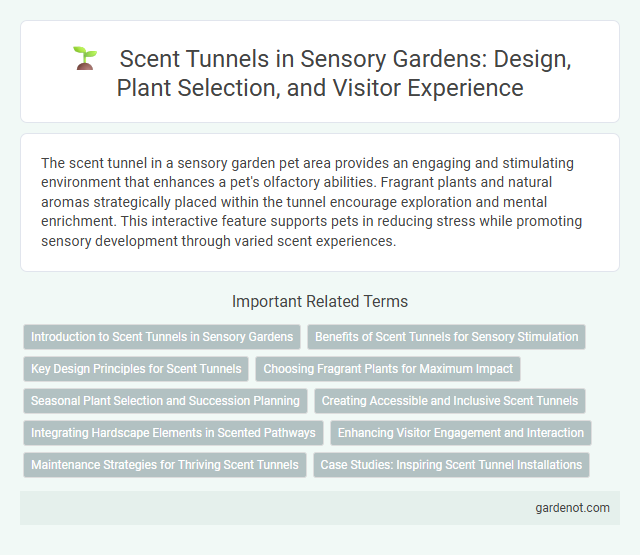The scent tunnel in a sensory garden pet area provides an engaging and stimulating environment that enhances a pet's olfactory abilities. Fragrant plants and natural aromas strategically placed within the tunnel encourage exploration and mental enrichment. This interactive feature supports pets in reducing stress while promoting sensory development through varied scent experiences.
Introduction to Scent Tunnels in Sensory Gardens
Scent tunnels in sensory gardens create immersive pathways filled with fragrant plants that stimulate the olfactory senses. These tunnels often feature aromatic herbs, flowers, and shrubs strategically planted to enhance the sensory experience and promote relaxation. Integrating a scent tunnel supports therapeutic goals by engaging smell to evoke memories and improve mood.
Benefits of Scent Tunnels for Sensory Stimulation
Scent tunnels in sensory gardens provide immersive olfactory experiences by surrounding visitors with a variety of natural aromas, enhancing sensory stimulation and promoting relaxation. These tunnels engage the limbic system, improving memory recall and emotional well-being while offering therapeutic benefits for individuals with sensory processing disorders. Incorporating diverse botanical scents supports cognitive development and sensory integration through multi-sensory interaction.
Key Design Principles for Scent Tunnels
Scent tunnels in sensory gardens are designed to engage the olfactory senses through carefully curated aromatic plants and materials arranged to guide visitors along a fragrant path. Key design principles include incorporating a diversity of scent profiles, layering plant heights for spatial depth, and ensuring accessibility with clear pathways and tactile elements. Attention to seasonal blooming cycles and scent intensity variation enhances sensory engagement and sustained visitor interest.
Choosing Fragrant Plants for Maximum Impact
Selecting fragrant plants such as lavender, jasmine, and rosemary ensures a strong and pleasing aroma within a scent tunnel. Native and drought-resistant species are ideal for sustainable growth and consistent fragrance release. Incorporating a variety of bloom times maintains scent intensity throughout different seasons, enhancing sensory engagement.
Seasonal Plant Selection and Succession Planning
Seasonal plant selection in a scent tunnel emphasizes aromatic species that bloom sequentially to maintain continuous fragrance throughout the year. Succession planning involves strategically arranging plants to ensure overlapping bloom periods, enhancing sensory stimulation and biodiversity. Incorporating native and drought-resistant varieties supports sustainability and adapts to climate variations effectively.
Creating Accessible and Inclusive Scent Tunnels
Designing scent tunnels with accessibility in mind ensures individuals with varying sensory abilities can fully experience aromatic environments. Utilizing adjustable scent intensity controls and incorporating tactile guide paths enhances inclusivity for visitors with visual impairments. Strategic placement of diverse fragrance sources within the tunnel supports cognitive engagement and broadens sensory exploration.
Integrating Hardscape Elements in Scented Pathways
Integrating hardscape elements in scented pathways of a sensory garden enhances both accessibility and sensory engagement by guiding visitors through tactile and aromatic experiences. Materials such as textured pavers, stone borders, and wooden trellises support the growth of fragrant plants while providing structural definition and durability. These elements create a harmonious blend of natural scents and architectural features, enriching the therapeutic and educational benefits of the scent tunnel.
Enhancing Visitor Engagement and Interaction
The scent tunnel in sensory gardens immerses visitors in a dynamic olfactory experience, stimulating the sense of smell through carefully curated aromatic plants and essential oils. Designed to encourage prolonged interaction, the tunnel heightens sensory awareness and fosters emotional connections with nature. Enhanced visitor engagement in this multisensory environment promotes mindfulness, relaxation, and educational exploration of diverse plant fragrances.
Maintenance Strategies for Thriving Scent Tunnels
Effective maintenance strategies for thriving scent tunnels include regular pruning of aromatic plants to encourage healthy growth and maximize fragrance release. Implementing soil moisture monitoring ensures optimal hydration levels, which supports the vitality of scent-producing flora. Periodic replacement of spent blooms and integration of pest management techniques help sustain the tunnel's sensory appeal and longevity.
Case Studies: Inspiring Scent Tunnel Installations
Scent tunnels enhance sensory gardens by immersing visitors in carefully curated aromatic experiences that stimulate memory and emotion. Notable case studies include the Royal Horticultural Society's Wisley Garden in the UK, where the scent tunnel features native herbs and flowers, creating an immersive olfactory journey aligned with seasonal changes. Another inspiring installation at the Chicago Botanic Garden integrates educational signage, allowing visitors to learn about the plants' botanical and therapeutic properties while experiencing their fragrances.
Scent tunnel Infographic

 gardenot.com
gardenot.com